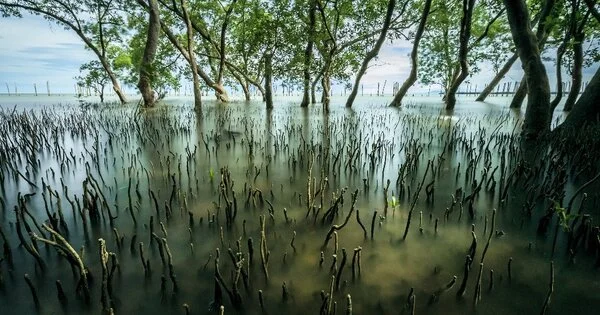According to a new study, restoring coastal vegetation – so-called ‘blue carbon’ habitats – may not be the nature-based climate solution that it is claimed to be. Researchers from the University of East Anglia (UEA), the French Centre National de la Recherche Scientifique (CNRS), and the Prince Albert II of Monaco Foundation challenge the widely held belief that restoring areas such as mangroves, saltmarsh, and seagrass can remove significant amounts of carbon dioxide (CO2) from the atmosphere in their study.
Their review findings, published today in the journal Frontiers in Climate, identify seven reasons why carbon accounting for coastal ecosystems is not only difficult but also risky. These factors include high variability in carbon burial rates, vulnerability to future climate change, and methane and nitrous oxide fluxes. The authors, who also looked at restoration costs, warn that additional measurements can reduce these risks, but at a much higher cost.
They emphasize, however, that blue carbon habitats should continue to be protected and, where possible, restored because they benefit climate adaptation, coastal protection, food provision, and biodiversity conservation.
Lead author Dr. Phil Williamson, honorary reader in UEA’s School of Environmental Sciences, said: “We have looked into the processes involved in carbon removal and there are just too many uncertainties. The expected climate benefits from blue carbon ecosystem restoration may be achieved, yet it seems more likely they will fall seriously short.”
We have looked into the processes involved in carbon removal and there are just too many uncertainties. The expected climate benefits from blue carbon ecosystem restoration may be achieved, yet it seems more likely they will fall seriously short.
Dr. Phil Williamson
“If you want more carbon removal, you need more habitat, and restoration options are limited.” Many of these areas have been developed for coastal settlement, tourism, and port development. Nonetheless, we believe that every effort should be made to halt and, if possible, reverse the global loss of coastal vegetation. This is because blue carbon habitats do more than just store carbon; they also protect against storms, support biodiversity and fisheries, and improve water quality.”
Organic carbon has been accumulated and stored in the sediments beneath mangrove forests, tidal saltmarshes, and seagrass meadows for hundreds of years. Many recent studies and reviews have found that these coastal blue carbon ecosystems have the potential to provide a natural climate solution in two ways: conservation, which reduces greenhouse gas emissions caused by habitat loss and degradation, and restoration, which increases carbon dioxide drawdown and long-term storage.
This new review focuses on the latter, assessing the feasibility of achieving quantified and secure carbon removal (negative emissions) through the restoration of coastal vegetation. Increasingly businesses and states have pledged to offset their emissions by restoring these ecosystems through carbon credits, assuming reliable knowledge on how much CO2 they will remove in the future from the atmosphere.

However, Dr. Williamson and co-author Prof Jean-Pierre Gattuso, of CNRS and the OACIS initiative of the Prince Albert II of Monaco Foundation, say the policy problem is more subtle. That is, CO2 removal using coastal blue carbon restoration has questionable cost-effectiveness when considered only as a climate mitigation action, either for carbon-offsetting or for inclusion in countries’ Nationally Determined Contributions, which set out their efforts to reduce emissions and adapt to the impacts of climate change under the Paris Agreement.
“If we use these ecosystems for carbon offsets in a significant way, expecting them to remove up to, say, 100 gigatonnes of CO2 over the period 2025-2100, but discover they only remove 10 or maybe just one gigatonne of CO2, then climate tipping points could be crossed, with really serious consequences,” Dr Williamson said.
“However, if such ecosystems are restored to protect biodiversity and we discover that they also remove several gigatonnes of CO2, that would be a bonus, assuming other methods of climate mitigation are used.”
“Restoration should therefore be in addition to, not as a substitute for, near-total emission reductions. Where coastal blue ecosystems restoration projects are carried out primarily for carbon removal, they need to include comprehensive long-term monitoring to verify that the intended climate benefits are being achieved.”
Professor Gattuso stated: “Many critical issues concerning the measurement of carbon fluxes and storage remain unresolved, affecting certification and potentially leading to over-crediting. Coastal blue carbon ecosystem restoration is still extremely beneficial for climate adaptation, coastal protection, food provision, and biodiversity conservation. Such action can thus be societally justified in a wide range of circumstances, owing to the numerous benefits that such habitats provide at the local level.”





